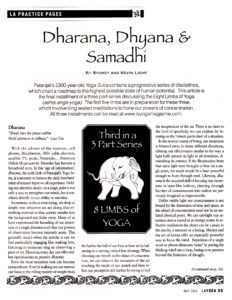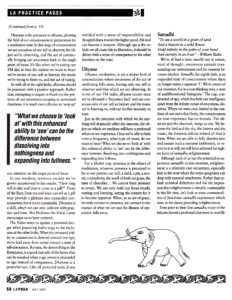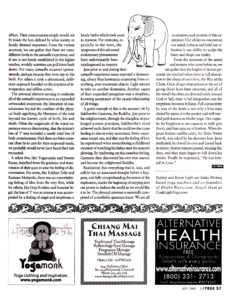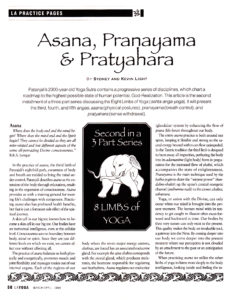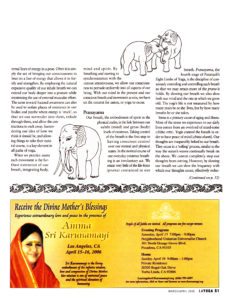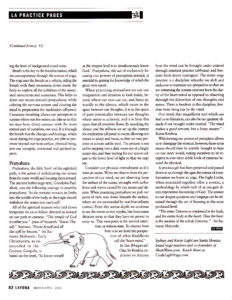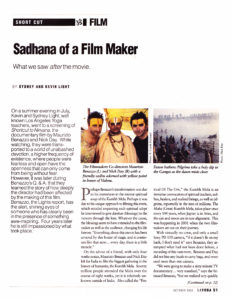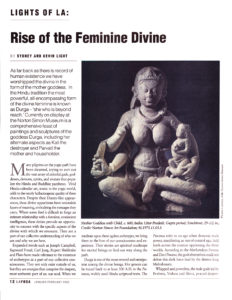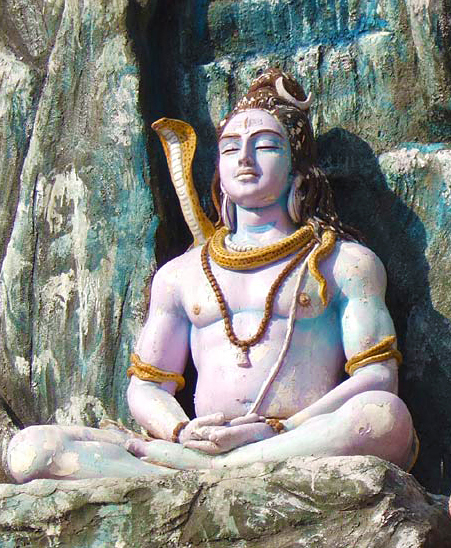This article is the second of an eight part series. It will present the second limb: yama (outward attitude and behavior) of the 8-fold path of Raja yoga.
It is a widely held Hindu belief that we are all just characters in one of God’s dreams. The eight limbs (angas) detail a methodical approach by which we can awaken within that dream. Ashta-anga-yoga has been specifically devised over many millennia with the sole intention of leading us to the highest possible state of human potential, God-Realization.
The Yamas: What We Think We Create
The yamas are the first limb of the eightfold yogic path taught by Patanjali. They consist of moral observances, which form the very foundation of spiritual discipline. We use the yamas as a guide for how we deal with the outer world, allowing our behavior and relationships to reflect an attitude of compassion. According to the Yoga Sutra there are five yamas:
- Ahimsa or non-harming
- Satya or truthfulness
- Asteya or nonstealing
- Brahmacarya or chastity
- Aparigraha or greedlessness.
These constitute the maha-vrata or ‘great vow’ of the yogin.
Ahimsa, nonviolence, means more than just the absence or negation of violence. Ahimsa is the practice of kindness in all thought, speech and action, developing a considerate attitude toward ourselves first and then extending benevolence outward in our behavior toward others. To effectively practice ahimsa we need to confront the source of violent impulses, fear and anger. Both fear and anger result in a contraction of our consciousness, isolating us from union with divine energy. Anger pulls a person’s vibration down and is an extremely wasteful expenditure of accumulated spiritual merit. In Buddhist teachings patience is recommended as a countermeasure for anger. However, being patient is much easier in theory than in practice, which is why they call it a practice.
Fear and anger often arise when we are not firmly established in the present. Fear stems from apprehension of a future event, while the source of anger is frequently an inability to let go of something in our past. Gratitude is a strong medicine for both. Negativity and gratitude cannot co-exist in the same space.
Perhaps the most formidable fear-obstacle we will inevitably face is our own death. Knowing that the end of this body is not the end of our existence is essential for developing the trust and surrender necessary to overcome our fear of death. The deeper we delve into our yoga practice, the more directly we can experience God and gain that knowledge.
Satya is the practice of truthfulness. It has been said that, “if you always speak the truth, everything you say will come true.” This means that truth is inherently powerful. When we only speak words we know to be true, we align ourselves with the vibration of creation. In meditation, when our mind is still, we can ‘hear’ the vibration of truth. It’s a feeling – a ‘knowing’ that is beyond words. For the yogi, the origin of truthful speech and action is truthful thought. Those who cause harm out of ignorance are less culpable than those who know what is right and still act otherwise. There is no value in knowing truth unless we act in truth.
Asteya addresses more than just non-stealing, it also means not coveting and not misusing the trust or confidence of another for our own personal gain. “The world has enough for every man’s need, but not every man’s greed.” (Mahatma Ghandhi).
In the west we tend to spend the first half of our life running around like crazed squirrels, gathering up as many nuts as we can find, not appreciating what is happening in the present moment. If we’re “successful” in accumulating, we then spend the second half of our life worrying about who’s going to take our nuts away. When we take more of the world’s resources than we can use, in a sense we are taking what is not ours. Giving away what we don’t need or use, recycling Mother Earth’s precious resources and performing acts of selfless service are all proactive ways in which we can cultivate asteya.
Brahmacharya is the containment of sexual energy for its conscious use. This is not necessarily instruction to choke off a natural urge from an outside-in approach, but to become aware of and contain all sexual energy down to the subtle level of thought. A person in a monogamous relationship or marriage can still be practicing brahmacharya if they keep their sexual energy within that closed circle. When we see a person, rather than negate our natural instincts, we can try to see them from the perspective of all of our chakras, not just the lower three. As yogis we aspire to look beyond the impermanent exterior to that which is eternal.
In the strictest literal sense, brahmacharya means the practice of celibacy. All of the yogin’s physical and psychic energy is directed towards the divine. Sexual energy is pulled upward from the lower to the higher chakras, fueling the spiritual growth and ultimate awakening of the yogi. Qualities in another person such as charisma, brilliance or artistry are in fact sexual energies transmuted. The yogic practices are designed to ignite and increase this energy, which by means of the yamas and niyamas, the yogi channels toward kindness away from ego.
Aparigraha, greedlessness, is a form of asteya and perhaps the most difficult yama for westerners to employ. It means ‘non-hoarding’ or not keeping more than one needs. To a sadhu in India, that would mean not possessing more than a loin cloth, a blanket and a bowl. To a westerner the line between “need” and “want” can often be very fuzzy
So how does a contemporary western yogi understand and practice aparigraha? Perhaps by giving away what is not being utilized. Our giving can also extend beyond the material so that we are not hoarding our caring or compassion for others either. It’s helpful to recognize all of energy as a flow; if one stops the flow of giving, one also impedes the flow of receiving
Through the practice of yama and niyama, we become channels for the good of the universe. Connecting with the truth residing in each of our hearts, connects us with all that is.
Loka Samasta Sukhino Bhavantu ~ May all beings be happy and at peace.
*{published Jan/Feb 2006 issue of ‘LA Yoga & Ayurveda Magazine’, by Sydney and Kevin Light}
This article is the first of an eight part series. It will present the first limb: niyama (inward moral observances) of the 8-fold path of Raja yoga.
The eight limbs of yoga (ashta-anga-yoga) expounded on in the 2,300-year-old Yoga Sutra compiled by Patanjali, are a progressive series of steps or disciplines, which purify the body and mind, providing us with the means to achieve direct experiential knowledge of God. They comprise a scientific system formulated such that the practice of each limb reinforces the others, ultimately bringing the practitioner to a state of yoga: union with cosmic consciousness.
The yamas and niyamas comprise the universal moral truths that are the backbone of every religion and spiritual practice. Although they are often misinterpreted as ‘shalt nots’ they cannot be effectively practiced in this way. It’s much more helpful to consider them as things that we ‘do.’ Rather than negate our behavior through censorship, it is a much more powerful practice to journey inward and address the impulses behind our actions.
Although the yamas are typically listed as the first limb of yoga, before purity can reflect in our actions it must exist in our thoughts. Therefore, the niyamas will be presented first in this article. Niyama, the second limb, has to do with purity of thought. Everything that exists has been preceded by thought. We are the co-creators of this reality.
The Niyamas: What We Think We Become
The niyamas address inner observance and self-discipline, how we treat ourselves. They lead to ‘right intention,’ which comes from the expanded perspective of doing what is best for all of consciousness, even at the expense of personal sacrifice. According to Patanjali’s Yoga Sutra, there are five niyamas:
- Shauca or purity
- Santosha or contentment
- Tapas or austerity
- Svadhyaya or self-study
- Ishvara-pranidhana or devotion to the Lord.
Shauca, purity, is important for both our inner and outer well being. Practicing good hygiene habits combined with asana and pranayama remove toxins and cleanse us inside and out. In a physical sense it means purity of body as well as purity in what we nourish the body with. This includes what we eat as well as how the food is obtained.
Perhaps even more important than the physical aspects of shauca is the purity of our thoughts, actions and deeds. Impure thoughts can be cleansed through the practice of bhakti or devotion, while faulty reasoning and perception can be purified by svadhyaya or introspective self-study. With a clear and lucid mind we are better equipped to practice the other limbs of yoga.
Santosha, contentment, is the means by which we free ourselves from the winds of desire. The practice of this niyama has become even more crucial in today’s consumer-based society where we have been conditioned since birth to believe the key to our happiness lies in some external thing. True and lasting happiness can only be attained as an internal state of being. So how do we go about ‘cultivating’ contentment?
We can set the context by practicing acceptance and gratitude. Acceptance – saying ‘yes’ to what is in this moment; gratitude – recognizing the grace we have already received. As we do, contentment and joy naturally arise.
Tapas refers to any austere practice requiring a burning, self-disciplined effort resulting in the purification of our character. Patanjali states in his Yoga Sutra that tapasya leads to perfection (siddhi) of the body and the senses. Tapas are those situations in life, contrived or naturally occurring, from which we can push off of, in order to propel ourselves higher. Whether engaging the body, speech or mind, tapasya entails a sustained and regimented endeavor to connect with the divine, while all obstacles are burned up and fall away.
Pranayama and asana are voluntary forms of tapasya. The Buddhist practice of vipassana is another example of an intentional tapasya, where the practitioner takes a ten day vow of silence and sits in meditation for eight hours a day. A disability such as a stroke can become an involuntary tapasya if the practitioner is able to adopt an attitude whereby they can use that condition to move closer to God.
However, the austerities, hardships, which help us to discern body from spirit, should not be taken to an extreme. The Bhagavad-Gita speaks out against exaggerated asceticism, which involves mortification of the flesh and ignores the fact that the Lord (Ishvara) resides within the body.
Svadyaya, self-inquiry encompasses all learning, reflection and experience, which result in a greater understanding of our own fundamental nature. It includes the study of sacred texts or any books that resonate with us in a way that moves us toward the light. Self-study is perhaps the most crucial of the niyamas because at some point we must all reconcile to the fact that although higher consciousness is within everyone’s grasp, no guru, priest or other person can do the work for us. Sri Ramana Maharshi, the great Indian saint who left his body in 1950, advocated self-inquiry as the primary proponent of sadhana (daily practice). He guided his followers toward freedom from ego-illusion by instructing them to always look to the source of the “I-thought.”
The Yoga Sutra says that as we progress on our path of self-study we develop a connection to the universal Divine laws and the spiritual masters who revealed them. Mantra is a way of strengthening our Divine connection, so svadyaya also includes kirtan and the repetition of mantra.
Ishvarapranidhana, devotion to the Lord literally means, ‘to lay all of our actions at the feet of God.’ It requires that we detach from the outcome of any endeavor, just do our best and leave the rest to a higher power. Ishvarapranidhana addresses ‘right intention.’
Is the source of our motivation behind a particular action ego-driven or is our intention selfless? Ram Dass, a spiritual pioneer who is, and has been, instrumental in introducing Eastern spirituality to the west, often speaks about dis-identifying with our ‘role’ as helper when performing acts of service. When we perform a good deed and there is nobody there as witness, did we acquire karmic merit? When a tree falls in the forest and there is nobody there to hear it, did it make a sound? The answer to both questions is a resounding ‘Yes,’ because both involve a transfer of energy, which according to Sir Isaac Newton can neither be created nor destroyed, but only transferred or transmuted.
Besides, Presence is always there as witness. In fact, when we perform acts of service with the knowledge that nobody will ever know, it is far more likely that our intention is pure.
Through the practice of yama and niyama, we become channels for the good of the universe. Connecting with the truth residing in each of our hearts, connects us with all that is.
Loka Samasta Sukhino Bhavantu ~ May all beings be happy and at peace.
*{published Jan/Feb 2006 issue of ‘LA Yoga & Ayurveda Magazine’, by Sydney and Kevin Light}

